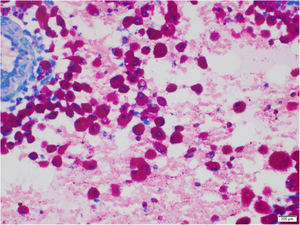Mycobacterium simiae
Classification
Bacteria; Actinobacteria; Actinobacteria; Actinomycetales; Mycobacteriaceae
Species
|
NCBI: [1] |
Mycobacterium simiae
Description and Significance
Mycobacterium simiae is most prevalent in Cuba, the Middle East, and southwestern United States. As of current research, only 10 strains of M. simiae have had their genomes sequenced. However, there have been increasing reports of M. simiae prevalence in western European countries, including Spain and France. This microbe can live in soil, water, and inside its host. It is an opportunistic pathogen and its host is humans. M. simiae was initially discovered in Rhesus monkeys and then evolved to infect humans. This microbe is becoming of increased importance to study as it causes pulmonary disease in humans. While many forms of pulmonary infection are treatable, M. simiae has no reliable treatment course.
Genome Structure
M. simiae has a total length of 6,684,413 bp fragmented in 50 contigs. These are the measurements for the largest strain of the microbe found to date, MsiGto. The sample was obtained from a patient in Guanajuato, Mexico. It is contained in a single, circular, chromosome. Due to the size of its gene sequence, it is predicted to thrive in both the environment and its human host.
Cell Structure, Metabolism and Life Cycle
This microbe is an opportunistic pathogen, so it can obtain its energy from its host. M. simiae has had sections of its genome correlated with the conversion of trehalose monomycolate into the Cord Factor trehalose dimycolate, which is considered one of the most important virulence factors of mycobacteria. This is most likely what gives the microbe its high virulence and dangerous effect on humans.
Ecology and Pathogenesis
M. simiae can live in soil, water, and in humans. The organism is considered a parasite in humans, and can have very deadly effects. It causes a form of pulmonary disease that is not easily treatable. It has a very high virulence, which is associated with a higher-than-average death rate. Different areas of the world have seen different effects of this pathogen. In Israel, medications such as rifampin, ethambutol, and clarithromycin have shown to be an effective treatment. However, these same medications in the United States have not been as effective.
References
Courtney B., “Nontuberculous Mycobacterial Infections”. Murray & Nadel’s Textbook of Respiratory Medicine. 2022.
Jabbour J-F., Hamieh A., Sharara SL., Kanj S., “Mycobacterium simiae: Harmless colonizer or deadly pathogen?”. PLoS Pathog. 16(4). 2020.
Jose L., Steffani V., Marion B., Erika A., “Genomic insights into Mycobacterium simiae human colonization”. Standards in Genomic Sciences. 2018.
Author
Page authored by Reeva Patel, student of Prof. Bradley Tolar at UNC Wilmington.

